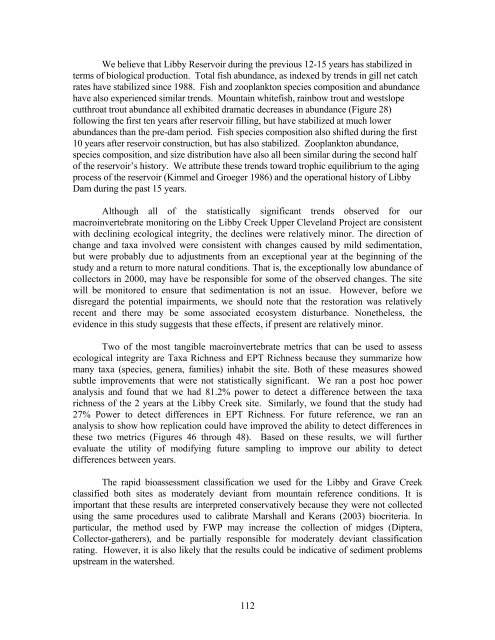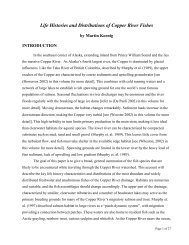Mitigation for the Construction and Operation of Libby Dam
Mitigation for the Construction and Operation of Libby Dam
Mitigation for the Construction and Operation of Libby Dam
You also want an ePaper? Increase the reach of your titles
YUMPU automatically turns print PDFs into web optimized ePapers that Google loves.
We believe that <strong>Libby</strong> Reservoir during <strong>the</strong> previous 12-15 years has stabilized in<br />
terms <strong>of</strong> biological production. Total fish abundance, as indexed by trends in gill net catch<br />
rates have stabilized since 1988. Fish <strong>and</strong> zooplankton species composition <strong>and</strong> abundance<br />
have also experienced similar trends. Mountain whitefish, rainbow trout <strong>and</strong> westslope<br />
cutthroat trout abundance all exhibited dramatic decreases in abundance (Figure 28)<br />
following <strong>the</strong> first ten years after reservoir filling, but have stabilized at much lower<br />
abundances than <strong>the</strong> pre-dam period. Fish species composition also shifted during <strong>the</strong> first<br />
10 years after reservoir construction, but has also stabilized. Zooplankton abundance,<br />
species composition, <strong>and</strong> size distribution have also all been similar during <strong>the</strong> second half<br />
<strong>of</strong> <strong>the</strong> reservoir’s history. We attribute <strong>the</strong>se trends toward trophic equilibrium to <strong>the</strong> aging<br />
process <strong>of</strong> <strong>the</strong> reservoir (Kimmel <strong>and</strong> Groeger 1986) <strong>and</strong> <strong>the</strong> operational history <strong>of</strong> <strong>Libby</strong><br />
<strong>Dam</strong> during <strong>the</strong> past 15 years.<br />
Although all <strong>of</strong> <strong>the</strong> statistically significant trends observed <strong>for</strong> our<br />
macroinvertebrate monitoring on <strong>the</strong> <strong>Libby</strong> Creek Upper Clevel<strong>and</strong> Project are consistent<br />
with declining ecological integrity, <strong>the</strong> declines were relatively minor. The direction <strong>of</strong><br />
change <strong>and</strong> taxa involved were consistent with changes caused by mild sedimentation,<br />
but were probably due to adjustments from an exceptional year at <strong>the</strong> beginning <strong>of</strong> <strong>the</strong><br />
study <strong>and</strong> a return to more natural conditions. That is, <strong>the</strong> exceptionally low abundance <strong>of</strong><br />
collectors in 2000, may have be responsible <strong>for</strong> some <strong>of</strong> <strong>the</strong> observed changes. The site<br />
will be monitored to ensure that sedimentation is not an issue. However, be<strong>for</strong>e we<br />
disregard <strong>the</strong> potential impairments, we should note that <strong>the</strong> restoration was relatively<br />
recent <strong>and</strong> <strong>the</strong>re may be some associated ecosystem disturbance. None<strong>the</strong>less, <strong>the</strong><br />
evidence in this study suggests that <strong>the</strong>se effects, if present are relatively minor.<br />
Two <strong>of</strong> <strong>the</strong> most tangible macroinvertebrate metrics that can be used to assess<br />
ecological integrity are Taxa Richness <strong>and</strong> EPT Richness because <strong>the</strong>y summarize how<br />
many taxa (species, genera, families) inhabit <strong>the</strong> site. Both <strong>of</strong> <strong>the</strong>se measures showed<br />
subtle improvements that were not statistically significant. We ran a post hoc power<br />
analysis <strong>and</strong> found that we had 81.2% power to detect a difference between <strong>the</strong> taxa<br />
richness <strong>of</strong> <strong>the</strong> 2 years at <strong>the</strong> <strong>Libby</strong> Creek site. Similarly, we found that <strong>the</strong> study had<br />
27% Power to detect differences in EPT Richness. For future reference, we ran an<br />
analysis to show how replication could have improved <strong>the</strong> ability to detect differences in<br />
<strong>the</strong>se two metrics (Figures 46 through 48). Based on <strong>the</strong>se results, we will fur<strong>the</strong>r<br />
evaluate <strong>the</strong> utility <strong>of</strong> modifying future sampling to improve our ability to detect<br />
differences between years.<br />
The rapid bioassessment classification we used <strong>for</strong> <strong>the</strong> <strong>Libby</strong> <strong>and</strong> Grave Creek<br />
classified both sites as moderately deviant from mountain reference conditions. It is<br />
important that <strong>the</strong>se results are interpreted conservatively because <strong>the</strong>y were not collected<br />
using <strong>the</strong> same procedures used to calibrate Marshall <strong>and</strong> Kerans (2003) biocriteria. In<br />
particular, <strong>the</strong> method used by FWP may increase <strong>the</strong> collection <strong>of</strong> midges (Diptera,<br />
Collector-ga<strong>the</strong>rers), <strong>and</strong> be partially responsible <strong>for</strong> moderately deviant classification<br />
rating. However, it is also likely that <strong>the</strong> results could be indicative <strong>of</strong> sediment problems<br />
upstream in <strong>the</strong> watershed.<br />
112
















